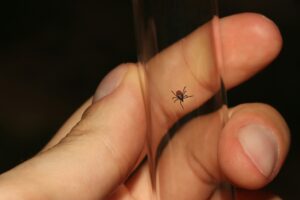If your child has just been diagnosed with Alpha-Gal Syndrome, you’re likely feeling overwhelmed, confused, and maybe even a little scared. You’re not alone — and we’re here to help.
Alpha-Gal Syndrome (AGS) is a tick-borne food allergy that makes it hard — and sometimes dangerous — for children (and adults) to eat red meat or products made from mammals. It’s still relatively unknown, even among some doctors and schools, which means parents often have to become the experts themselves.
In this guide, you’ll learn:
- What Alpha-Gal Syndrome is and how it happens
- Which foods and ingredients to avoid (some are sneaky!)
- What symptoms to watch for
- How to explain Alpha-Gal to your child
- How to stay safe at school, parties, and on the go
- Essential tools and resources to make daily life easier
Let’s break it all down so you can feel more confident navigating this condition and keeping your child safe.
What Is Alpha-Gal Syndrome?
Alpha-Gal Syndrome is an allergy to a sugar molecule called galactose-alpha-1,3-galactose (nicknamed Alpha-Gal), which is found in the meat, milk, and products made from most mammals — like cows, pigs, and sheep.
What makes this allergy unique is:
- It’s triggered by a tick bite, most commonly from the Lone Star Tick in the U.S.
- The allergic reaction is usually delayed — symptoms often show up 3 to 6 hours after eating mammal-based food.
- It can range from mild symptoms to life-threatening anaphylaxis.
Unlike typical food allergies, which often start in childhood, Alpha-Gal can show up anytime after a tick bite, even in previously healthy kids.
How Do You Get Alpha-Gal?
Alpha-Gal Syndrome develops after being bitten by a tick — especially the Lone Star Tick, which is commonly found in the southeastern and mid-Atlantic U.S.
Here’s how it works:
- The tick feeds on a mammal (like a deer or raccoon).
- It picks up the Alpha-Gal sugar from the mammal’s blood.
- When the tick bites a human, it injects that sugar into the person’s body.
- The immune system sees it as a threat and creates IgE antibodies.
- Now, when that person eats anything with Alpha-Gal (like beef or gelatin), their body overreacts with an allergic response.
This makes Alpha-Gal a delayed-onset food allergy caused by a bug bite — something most people have never heard of before.
Common Alpha-Gal Symptoms in Kids
Reactions vary widely from child to child, but common symptoms include:
🟡 Mild to Moderate Symptoms:
- Hives or itchy rash
- Stomach pain or nausea
- Vomiting or diarrhea
- Headache
- Feeling flushed or hot
- Dizziness or fatigue
🔴 Severe (Anaphylactic) Reactions:
- Difficulty breathing
- Swelling of lips, tongue, or throat
- Drop in blood pressure
- Fainting or confusion
Because reactions are delayed, it can be hard to connect the dots. A child may eat a burger at lunch and have symptoms at bedtime. Many families go through multiple misdiagnoses before learning it’s Alpha-Gal.
Foods and Ingredients to Avoid with Alpha-Gal
Here’s where it gets tricky: it’s not just meat.
Alpha-Gal can hide in many everyday products and foods. Here’s what to watch for:
High-Risk Foods:
- Beef, pork, lamb, goat, venison
- Bacon, sausage, deli meats
- Gelatin (used in gummies, marshmallows, some vitamins)
- Dairy (milk, cheese, butter, cream, whey, casein)
- Broths or gravies made with beef or pork stock
- Meat-based natural flavorings (in soups, chips, or seasoning mixes)
Hidden Ingredients to Look For:
- Tallow (animal fat)
- Lard
- Glycerin or stearates (in food and medications)
- Enzymes (in baked goods and cheese)
- Gel caps (in over-the-counter meds and supplements)
Always read the label. If it’s unclear, call the manufacturer or skip it to be safe.
What Can Kids with Alpha-Gal Eat?
The good news: there are still plenty of safe foods your child can enjoy!
✅ Safe Categories:
- Poultry (chicken, turkey)
- Fish and shellfish (unless your child also reacts to these)
- Eggs
- Fruits and vegetables
- Grains (rice, oats, corn, quinoa)
- Legumes (beans, lentils, soy)
- Most vegan and plant-based foods
Alpha-Gal at School: What Parents Need to Know
School can be one of the hardest places to manage Alpha-Gal — but with the right communication, your child can thrive.
✅ Tips for Talking to the School:
- Provide a one-page info sheet explaining Alpha-Gal
- Meet with the teacher, school nurse, and cafeteria staff
- Ask about food in the classroom (birthdays, rewards, crafts)
- Leave a safe snack stash at school for surprise parties
- Make sure staff is trained on your child’s emergency response plan
- Consider a 504 Plan to formalize accommodations
You can download a free Alpha-Gal School Safety Kit from our printables page.
Birthday Parties, Restaurants & Playdates
Social events can bring anxiety when food is involved. Here’s how to prepare:
Parties:
- Ask the host what food will be served
- Bring a safe version of the same treat for your child
- Pack safe snacks in a “party pouch” for last-minute invites
Restaurants:
- Call ahead to ask about ingredient transparency
- Avoid buffets and fried foods (cross-contact risk!)
- Stick with vegan or vegetarian options but still double-check
Label Reading Tips:
- Learn to spot “sneaky meat” ingredients (broth, enzymes, gelatin)
- Look for vegan-certified symbols as a shortcut
- Use apps like Fig or Sift to scan barcodes and get alerts
Helping Your Child Understand Alpha-Gal
Explaining Alpha-Gal to a young child can be tricky, but empowering them early builds independence.
Tips for Teaching:
- Use age-appropriate books (like Max and the Moo Mystery!)
- Practice saying “No thank you, I have an allergy”
- Play “label detective” at the grocery store together
- Celebrate Moo-Free wins (finding a new safe snack = superpower!)
Kids do best when they feel confident, not fearful. The goal is to raise awareness without creating anxiety.
Tools Every Alpha-Gal Family Should Have
Here are a few essentials we recommend for daily life with Alpha-Gal:
- EpiPen or epinephrine auto-injector (if prescribed)
- Allergy alert bracelet (like Allermates)
- Lunchbox with allergy label
- Tick repellent & tick check cards
- Safe snack stash for school, car, and travel
- Custom emergency plan printout
- Alpha-Gal Safe Product List (coming soon to our site!)
Trusted Resources for Parents
When you’re navigating Alpha-Gal, solid information matters. Here are some reliable sites:
- AlphaGalInformation.org – Patient-centered resource with printables
- CDC Alpha-Gal page – Basic overview and tick safety
- UVA Alpha-Gal Research Center – Leading science and research
- FARE (Food Allergy Research & Education) – For 504 plans and school tools
We also recommend joining a Facebook support group for up-to-date product reviews and tips from real families.
Final Thoughts: You’ve Got This
Getting an Alpha-Gal diagnosis for your child is scary. There’s so much to learn, and the learning curve is steep — but the fact that you’re reading this means you’re already doing the most important thing: advocating for your child’s health and safety.
With the right tools, clear communication, and a little creativity, your child can live a joyful, full life — one safe snack, one party, one day at a time.
You’re not in this alone.
Or check out our children’s book Max and the Moo Mystery — the first Alpha-Gal adventure story made just for kids.



